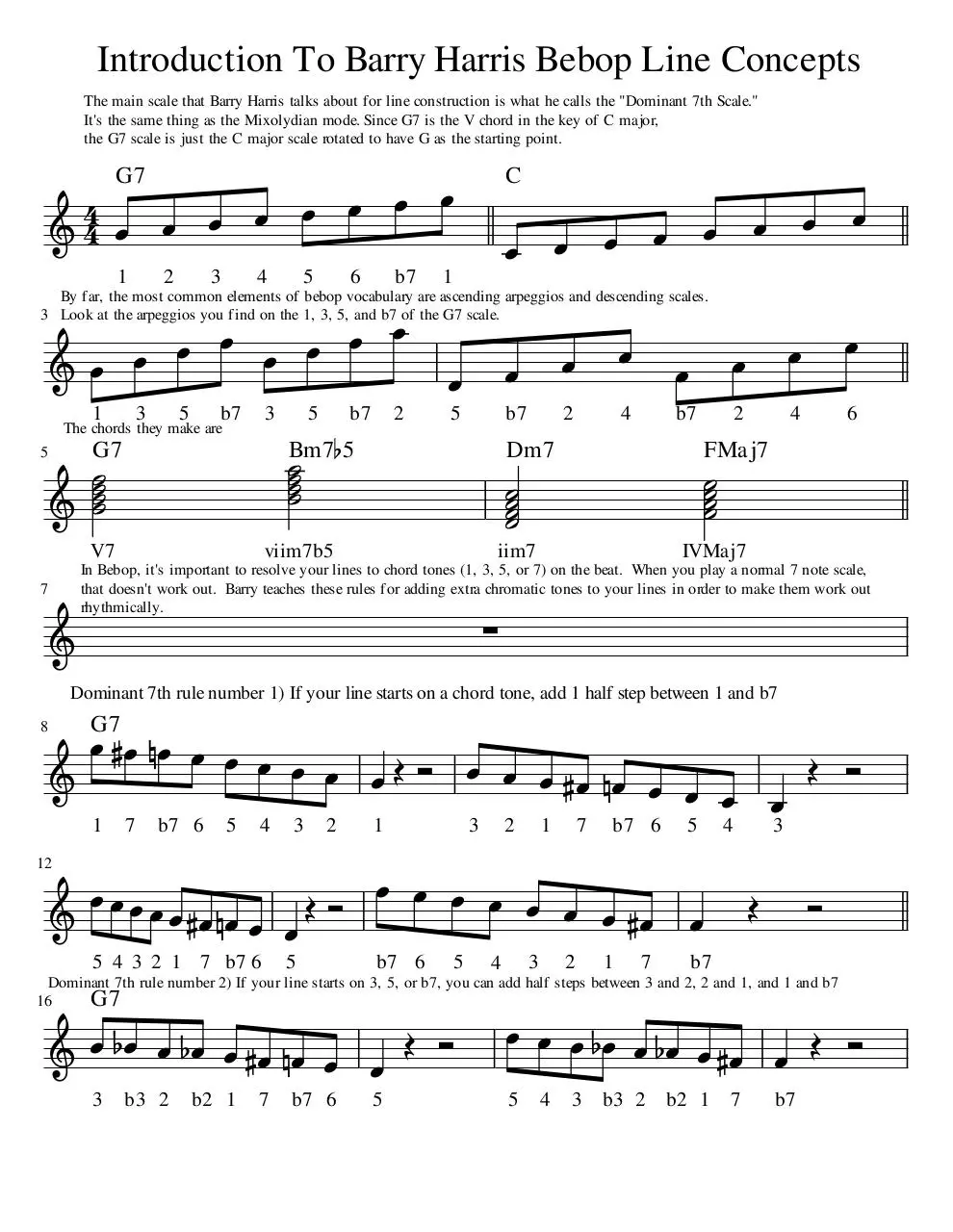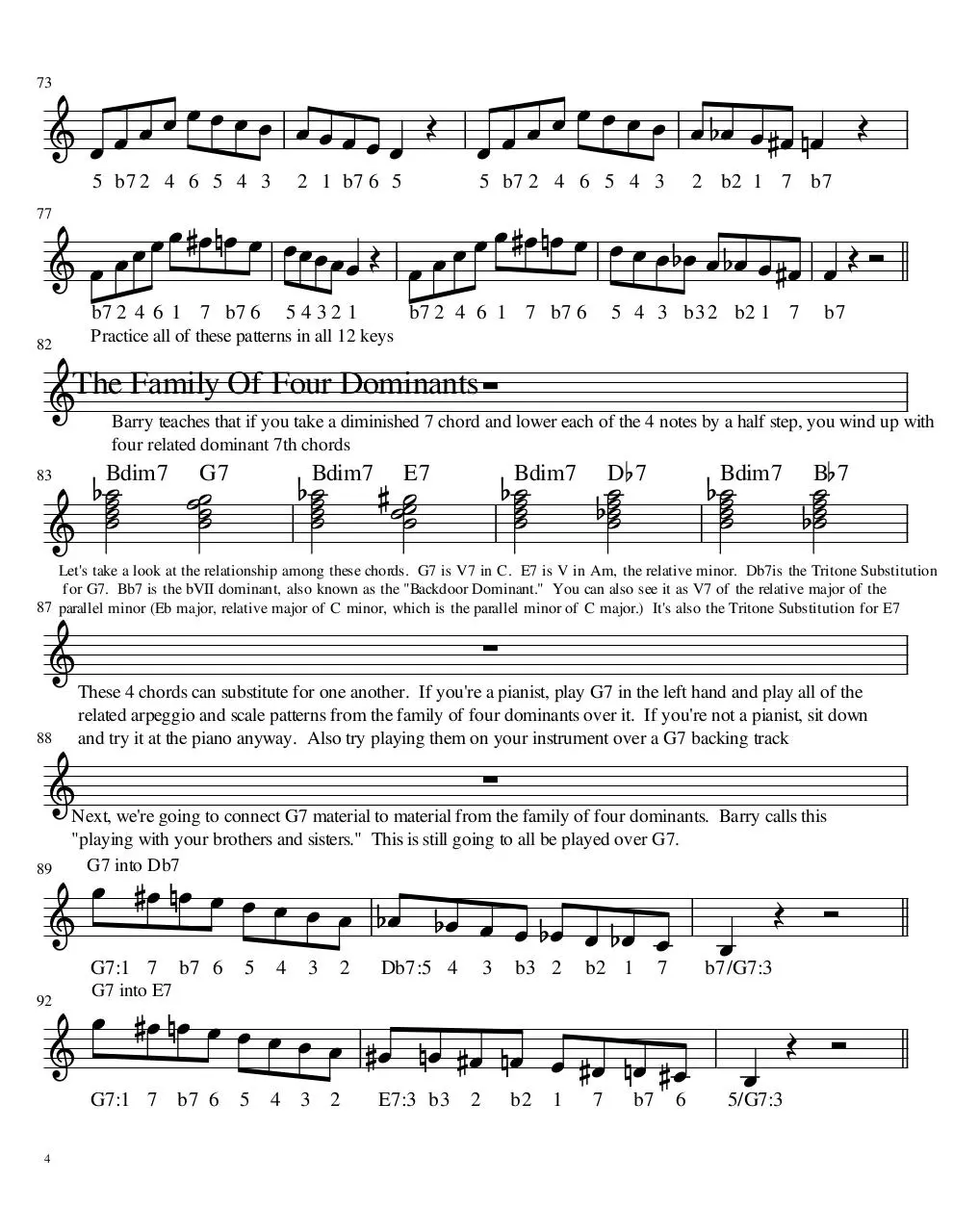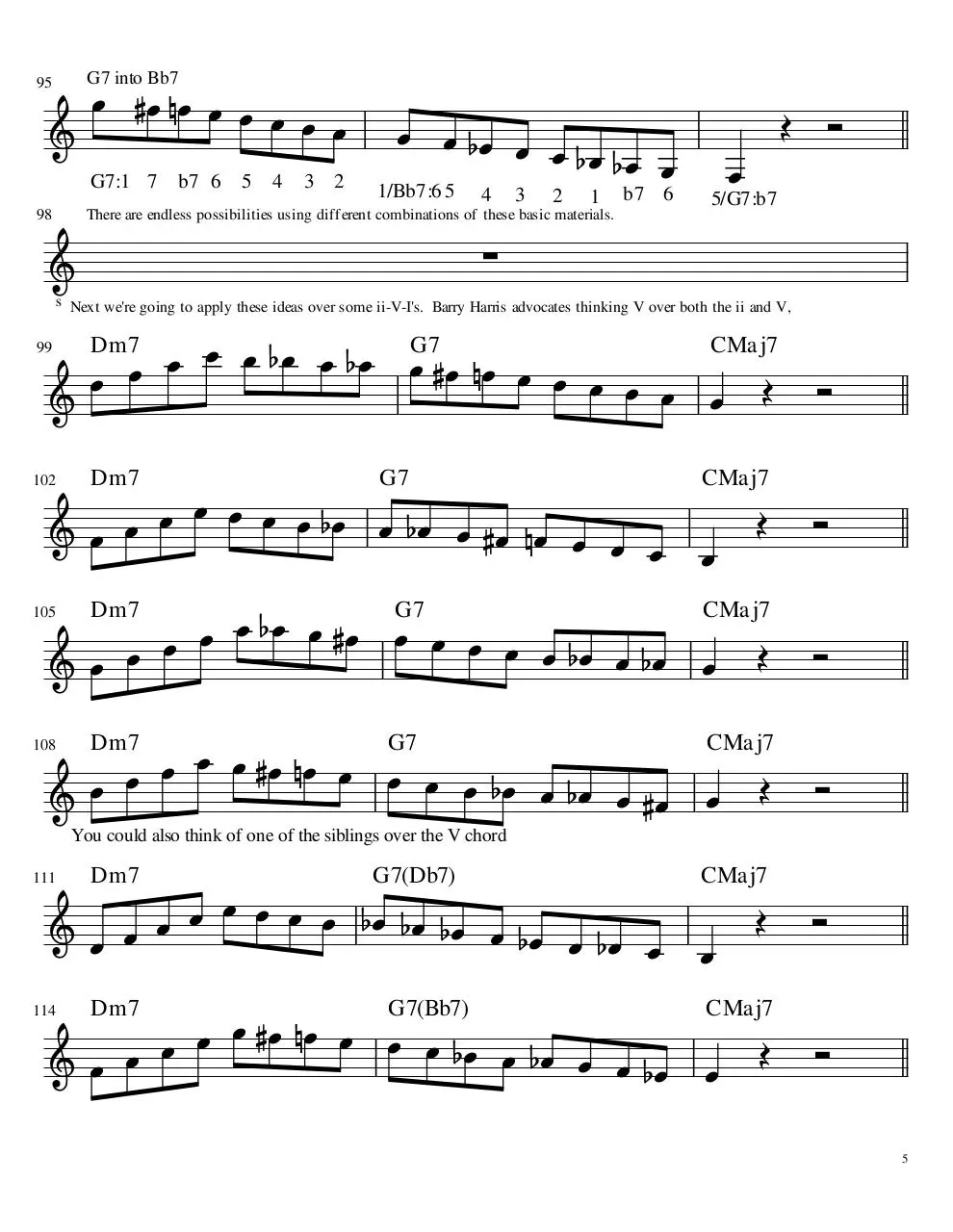Barry Harris Bebop Line Concepts (PDF)
File information
Title: Title
This PDF 1.4 document has been generated by MuseScore Version: 2.1.0 / Qt 5.4.2, and has been sent on pdf-archive.com on 11/02/2018 at 20:06, from IP address 24.125.x.x.
The current document download page has been viewed 9909 times.
File size: 81.37 KB (7 pages).
Privacy: public file





File preview
Introduction To Barry Harris Bebop Line Concepts
The main scale that Barry Harris talks about for line construction is what he calls the "Dominant 7th Scale."
It's the same thing as the Mixolydian mode. Since G7 is the V chord in the key of C major,
the G7 scale is just the C major scale rotated to have G as the starting point.
G7
C
4
4
1
2
3
4
5
6
b7
1
By far, the most common elements of bebop vocabulary are ascending arpeggios and descending scales.
3 Look at the arpeggios you find on the 1, 3, 5, and b7 of the G7 scale.
1
3
5
b7
3
The chords they make are
G7
5
5
b7
2
5
b7
Bm7♭5
V7
viim7b5
2
4
b7
2
4
Dm7
FMaj7
iim7
IVMaj7
6
In Bebop, it's important to resolve your lines to chord tones (1, 3, 5, or 7) on the beat. When you play a normal 7 note scale,
that doesn't work out. Barry teaches these rules for adding extra chromatic tones to your lines in order to make them work out
rhythmically.
7
Dominant 7th rule number 1) If your line starts on a chord tone, add 1 half step between 1 and b7
G7
8
1
7
b7 6
5
4
3
2
1
3
2
1
7
b7 6
5
4
3
12
5 4 3 2 1 7 b7 6
5
b7 6
5
3
4
2
1
7
b7
Dominant 7th rule number 2) If your line starts on 3, 5, or b7, you can add half steps between 3 and 2, 2 and 1, and 1 and b7
G7
16
3
b3 2
b2 1
7
b7 6
5
5
4
3 b3 2
b2 1
7
b7
20
b7
6
5
4
3
b3
2
b2
1
Dominant 7 rule number 3) if your line starts on 2, 4, or 6, no half steps are required
G7
22
2 1 b7 6 5 4 3 2
1
4 3 2
1 b7 6 5 4
3
26
6
5
4
3
2
1
7
6
5
Dominant 7th rule number 4) if your line starts on 2, 4, or 6, you can add half steps between 2 and 1, and 1 and b7
G7
28
2
b2 1
7
b7 6
5
4
3
4
3
2
b2 1
7
b7 6
5
32
6
34
5
4
3
2
b2
1
b7
7
Note: On Major 7 chords, the rules are all the same, except the half step between 1 and b7 is moved to be between 6 and 5
Now play each of the 4 arpeggios and resolve them down a step into a descending scale using all applicable rules
35
G7
1 3 5 b7 6 5 4 3
2 1 b7 6 5
1 3 5 b7 6 5 4 3
2 b2 1 7 b7
39
3 5 b7 2 1 7 b7 6
2
5 4 3 2 1
3 5 b7 2 1 7 b7 6
5 4 3 b3 2 b2 1
43
5 7 2 4 3 2 1 7
b7 6 5 4 3
5 b7 2 4 3 b3 2 b2
1 7 b7 6 5
47
b7 2 4 6 5 4 3 2
51
1 7 b7 6 5
b7 2 4 6 5 4 3 b3
2 b2 1 7 b7
Also play the arpeggios resolving up a step to a descending scale, with all applicable rules
1
3
5
b7
1
7
b7
6
5
4
3
2
1
53
3 5 b7 2 3 2 1 7
b7 6 5 4 3
3
5 b7 2
3 b3 2 b2
1 7 b7 6 5
57
5 b7 2 4 5 4 3 2
1 7 b7 6 5
5 b7 2 4 5 4 3 b3
2 b2 1 7 b7
61
b7 2 4 6 b7 6 5 4
65
3 2 1 7 b7
b7 2 4 6 b7 6 5 4
3 b3 2 b2 1
Now try resolving the arpeggios up a third to a descending scale, again, observing all applicable rules
1 3 5 b7 2 1 b7 6
5 4 3 2 1
1 3 5 b7 2 b2 1 7
b7 6 5 4 3
69
3 5 b7 2 4 3 2 1
b7 6 5 4 3
3 5 b7 2 4 3 2 b2
1 7 b7 6 5
3
73
5 b7 2 4 6 5 4 3
2 1 b7 6 5
5 b7 2 4 6 5 4 3
2 b2 1 7 b7
77
b7 2 4 6 1 7 b7 6
5432 1
b7 2 4 6 1 7 b7 6
5 4 3 b3 2 b2 1 7
b7
Practice all of these patterns in all 12 keys
82
The Family Of Four Dominants
Barry teaches that if you take a diminished 7 chord and lower each of the 4 notes by a half step, you wind up with
four related dominant 7th chords
Bdim7
83
G7
Bdim7 E7
Bdim7
D♭7
Bdim7
B♭7
Let's take a look at the relationship among these chords. G7 is V7 in C. E7 is V in Am, the relative minor. Db7is the Tritone Substitution
for G7. Bb7 is the bVII dominant, also known as the "Backdoor Dominant." You can also see it as V7 of the relative major of the
87 parallel minor (Eb major, relative major of C minor, which is the parallel minor of C major.) It's also the Tritone Substitution for E7
These 4 chords can substitute for one another. If you're a pianist, play G7 in the left hand and play all of the
related arpeggio and scale patterns from the family of four dominants over it. If you're not a pianist, sit down
and try it at the piano anyway. Also try playing them on your instrument over a G7 backing track
88
89
Next, we're going to connect G7 material to material from the family of four dominants. Barry calls this
"playing with your brothers and sisters." This is still going to all be played over G7.
G7 into Db7
G7:1 7
92
b7 6
5
4
3
2
Db7:5 4
3
b3 2
b2 1
7
b7/G7:3
G7 into E7
G7:1 7 b7 6
4
5
4
3 2
E7:3 b3
2
b2
1
7
b7
6
5/G7:3
G7 into Bb7
95
G7:1 7
b7 6
5
4
3 2
1/Bb7:6 5
4
3
2
1
b7 6
5/G7:b7
There are endless possibilities using different combinations of these basic materials.
98
s Next we're going to apply these ideas over some ii-V-I's. Barry Harris advocates thinking V over both the ii and V,
99
Dm7
G7
CMaj7
102
Dm7
G7
CMaj7
G7
CMaj7
105
Dm7
G7
108
Dm7
CMaj7
You could also think of one of the siblings over the V chord
111
Dm7
G7(Db7)
G7(Bb7)
114
Dm7
CMaj7
CMaj7
5
Dm7
117
G7(E7)
CMaj7
Now try using some of the siblings over the ii chord too. Notice how in this particular example,resolving
back into the I chord, you naturally get what is commonly called a "chromatic enclosure."
120
Dm7(Db7)
CMaj7
G7(Db7)
He shows us that this same material works over a minor ii-V. In the relative minor (A minor,) the ii-V is Bm7b5 to E7
Bm7b5 is really just 3 5 b7 and 9 (2) of G7. Barry suggests playing G7 to E7, or one of it's siblings, like G7 to Bb7
123
Bm7♭5(G7)
Am
E7
Bm7♭5(G7)
E7(Bb7)
Am
126
It's also important to every once in a while displace your line by an octave. Barry calls this "pivoting"
G7
129
etc
Another very important element of the language is triplets. The first place to learn to play triplets is in your arpeggios.
G7
133
3
3
3
137
3
Also try starting your line with a turn up and back down in triplets
141
3
6
3
3
147
Practice as many different combinations as you can think of. Practice them in every key. Really internalize them
and sing them. Listen closely to master bebop players like Charlie Parker, Bud Powell, or Barry Harris,
and hear how they're utilizing this material. Obviously this is not intended to be a complete listing of every
possible element of the vocabulary, but really internalizing these concepts will go a long way towards being able
to play this music with confidence and authenticity.
Just as an addendum, I have not personally studied with Dr. Harris, but since discovering his concepts recently,
I have watched just about every video available of either him explaining his concepts, or his students explaining
his concepts, and I feel like I've got a pretty good grasp on them. In my experience, even after having played
jazz for over 15 years, learning about these ideas has made my playing take a quantum leap forward, so whether
you're a beginner or a very experienced player, I think there's a lot to learn from this stuff.
7
Download Barry Harris Bebop Line Concepts
Barry_Harris_Bebop_Line_Concepts.pdf (PDF, 81.37 KB)
Download PDF
Share this file on social networks
Link to this page
Permanent link
Use the permanent link to the download page to share your document on Facebook, Twitter, LinkedIn, or directly with a contact by e-Mail, Messenger, Whatsapp, Line..
Short link
Use the short link to share your document on Twitter or by text message (SMS)
HTML Code
Copy the following HTML code to share your document on a Website or Blog
QR Code to this page

This file has been shared publicly by a user of PDF Archive.
Document ID: 0000732955.